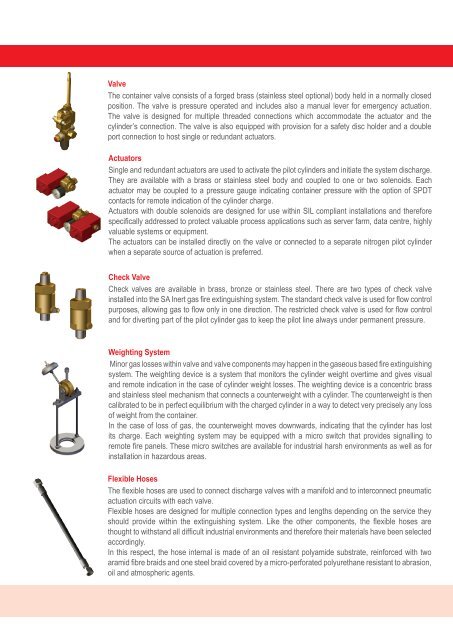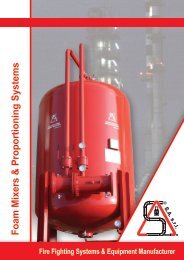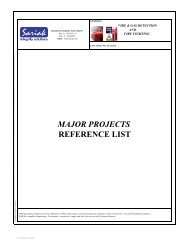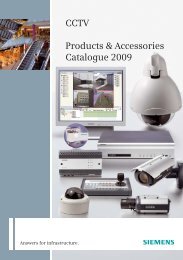Inert Gas Fire Extinguishing System - Sariak
Inert Gas Fire Extinguishing System - Sariak
Inert Gas Fire Extinguishing System - Sariak
You also want an ePaper? Increase the reach of your titles
YUMPU automatically turns print PDFs into web optimized ePapers that Google loves.
Valve<br />
The container valve consists of a forged brass (stainless steel optional) body held in a normally closed<br />
position. The valve is pressure operated and includes also a manual lever for emergency actuation.<br />
The valve is designed for multiple threaded connections which accommodate the actuator and the<br />
cylinder’s connection. The valve is also equipped with provision for a safety disc holder and a double<br />
port connection to host single or redundant actuators.<br />
Actuators<br />
Single and redundant actuators are used to activate the pilot cylinders and initiate the system discharge.<br />
They are available with a brass or stainless steel body and coupled to one or two solenoids. Each<br />
actuator may be coupled to a pressure gauge indicating container pressure with the option of SPDT<br />
contacts for remote indication of the cylinder charge.<br />
Actuators with double solenoids are designed for use within SIL compliant installations and therefore<br />
specifically addressed to protect valuable process applications such as server farm, data centre, highly<br />
valuable systems or equipment.<br />
The actuators can be installed directly on the valve or connected to a separate nitrogen pilot cylinder<br />
when a separate source of actuation is preferred.<br />
Check Valve<br />
Check valves are available in brass, bronze or stainless steel. There are two types of check valve<br />
installed into the SA <strong>Inert</strong> gas fire extinguishing system. The standard check valve is used for flow control<br />
purposes, allowing gas to flow only in one direction. The restricted check valve is used for flow control<br />
and for diverting part of the pilot cylinder gas to keep the pilot line always under permanent pressure.<br />
Weighting <strong>System</strong><br />
Minor gas losses within valve and valve components may happen in the gaseous based fire extinguishing<br />
system. The weighting device is a system that monitors the cylinder weight overtime and gives visual<br />
and remote indication in the case of cylinder weight losses. The weighting device is a concentric brass<br />
and stainless steel mechanism that connects a counterweight with a cylinder. The counterweight is then<br />
calibrated to be in perfect equilibrium with the charged cylinder in a way to detect very precisely any loss<br />
of weight from the container.<br />
In the case of loss of gas, the counterweight moves downwards, indicating that the cylinder has lost<br />
its charge. Each weighting system may be equipped with a micro switch that provides signalling to<br />
remote fire panels. These micro switches are available for industrial harsh environments as well as for<br />
installation in hazardous areas.<br />
Flexible Hoses<br />
The flexible hoses are used to connect discharge valves with a manifold and to interconnect pneumatic<br />
actuation circuits with each valve.<br />
Flexible hoses are designed for multiple connection types and lengths depending on the service they<br />
should provide within the extinguishing system. Like the other components, the flexible hoses are<br />
thought to withstand all difficult industrial environments and therefore their materials have been selected<br />
accordingly.<br />
In this respect, the hose internal is made of an oil resistant polyamide substrate, reinforced with two<br />
aramid fibre braids and one steel braid covered by a micro-perforated polyurethane resistant to abrasion,<br />
oil and atmospheric agents.





